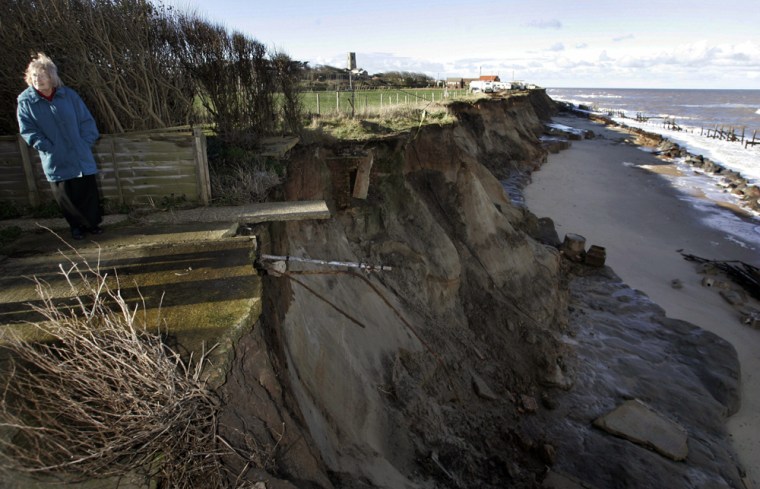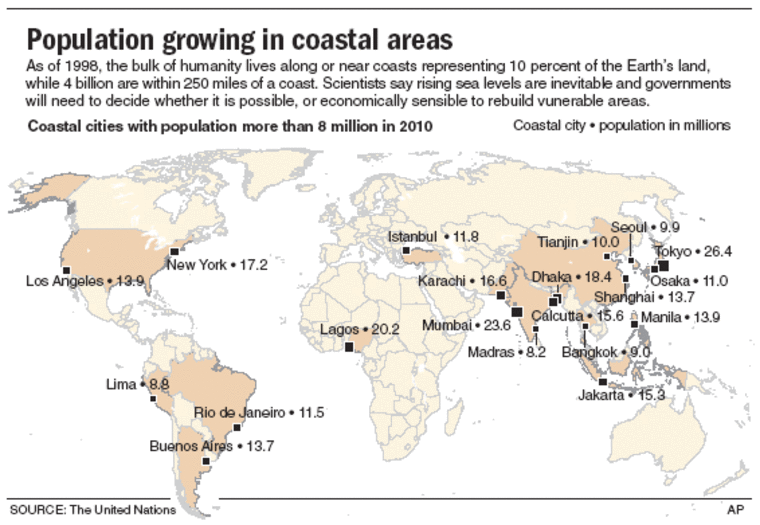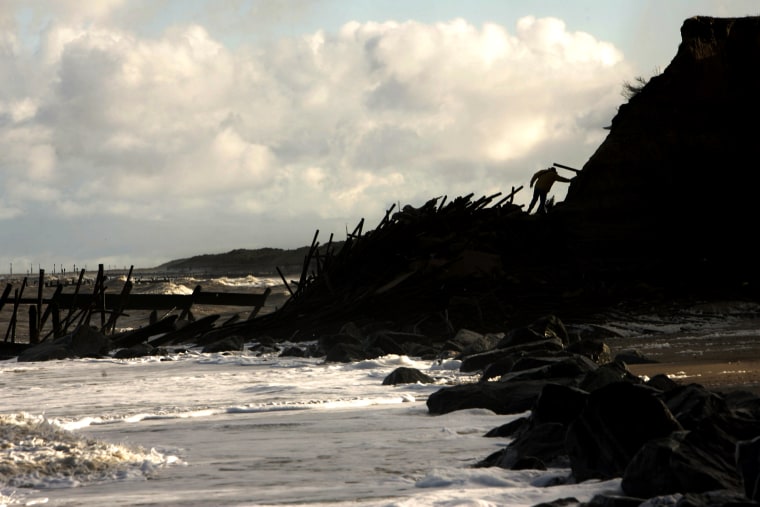A 12-bedroom guest house with beautiful views of the North Sea, a lighthouse and sandy beaches would normally be considered prime property in Britain, a nation where real estate prices are booming.
But Cliff House is nearly worthless.
The offshore wooden barrier that once protected the sand and clay cliffs where the house sits in this quaint village has broken apart, and the government has decided not to replace it.
"The next big storm could take us away," said Diana Wrightson, one of two elderly women who bought Cliff House 26 years ago, assuming the coastline would always be protected.
Across Britain, the expected rise in sea levels and storm surges that experts attribute to global warming means that some vulnerable coastal areas just are not worth defending any more.
Experts say receding coastlines are a crisis felt around the world. Some examples:
- Indonesia's environment minister has predicted that some 2,000 of Indonesia's estimated 18,000 islands would be swallowed by the sea in three decades because of climate change.
- Bangladesh, a low-lying country with 145 million people that often is battered by floods, tornadoes and cyclones, could see 5 million of its residents displaced if predictions for rising sea levels are correct, according to its environment secretary.
- Low-lying South Pacific countries are asking their islanders to prepare for a complete exodus as rising seas threaten to swamp their homes.
The phenomenon of environmental refugees is something most often associated with the developing world. But Britain is part of a growing club of rich countries whose coastal populations are also under threat.
U.S. coasts not immune
As temperatures rise and ice sheets in the Arctic and Antarctic melt, California and its world-famous seaside resorts are bracing for submerged coastal homes and eroded beaches. A combination of rising sea levels and stronger storms also could inundate many low-lying neighborhoods of New York, a city where four of the five boroughs are on islands.
Tragedies such as Hurricane Katrina, which devastated New Orleans in 2005, persuaded some scientists that stronger storms are now inevitable, and for that reason it may no longer be possible, or economically sensible, to defend or rebuild such vulnerable areas.
Over the past century, Louisiana has lost more than 2,000 square miles of coast. Meanwhile, levees are sinking, barrier islands are eroding and scientists worry that sea level rise will swamp many low-lying areas.

The damaging 2004 and 2005 hurricane seasons caused tens of billions of dollars in insured losses in the United States, including $40 billion from Katrina alone, according to the Insurance Information Institute.
Wealthy nations such as Britain, the Netherlands, Italy and the United States are now recalculating their defense plans because of global warming.
Last week, scientists from 113 countries issued a landmark report in Paris saying they have little doubt global warming is caused by man, and predicting that hotter temperatures and rises in sea level will "continue for centuries" no matter how much humans control their pollution.
They forecast temperature rises of (2 to 11.5 degrees Fahrenheit) and sea level rises of 7-23 inches by the end of the century. An additional 3.9-7.8 inches are possible if recent, surprising melting of polar ice sheets continues. The report also said the increase in hurricane and tropical cyclone strength since 1970 "more likely than not" can be attributed to man-made global warming.
The report did not identify areas of the world that will now be more vulnerable to flooding because issues such as topography, wind flows and storm surges influence the way each region would be affected by global sea level changes.

Sea rise and inland reach
But one rule of thumb, disputed among specialists, holds that each millimeter rise in sea level can reach inward and inundate 1.5 meters — 5 feet — of shallow ocean beach. The oceans have already expanded, rising an average 1 to 2 millimeters a year — up to one inch (2.54 centimeters) every 12 years — during the 20th century. Satellite measurements show a recent acceleration to 3 millimeters a year. The rise results both from the thermal expansion of ocean water as it warms, and from the runoff of melting ice sheets and glaciers.
Late last year, Britain issued "The Stern Review," a sweeping report about climate change that said if no action is taken, rising sea levels, heavier floods and more intense droughts could leave 200 million people displaced by the middle of the century.
"Whatever the climate change predictions of the future, the number of residential areas that already are suffering from the impact of more erosion, higher sea levels, storm surges and increased risk of flooding are being broken every year," said Paul Van Hofwegen of the World Water Council, a think tank based in Marseille, France.
In England, coastline recession already is increasing because of more frequent storms and increasing sea levels, its environment agency said. It has no overall figures for land loss, but it is conducting a national erosion risk mapping project, which will project the likely erosion over the next 100 years.
English town erodes
Like the peninsula of Cape Cod, Mass., the eastern English county of Norwich — where Happisburgh is located — has suffered coastal erosion for years.
Since 1990, when Happisburgh's offshore wooden barrier began to break apart, exposing its soft cliffs to the pounding surf of the North Sea, about 25 bungalows have been lost to erosion in the picturesque village of Edwardian homes that is home to 850 people.
A garage, several bungalows and a small road that once separated Cliff House from the North Sea are gone. The guest house now sits about 15 feet from the edge of the crumbling cliff and no longer accepts visitors.
Wrightson and her partner are moving their possessions to a home they have rented further inland, knowing they won't be able to stay much longer. When Cliff House goes, they will not receive compensation from the government or their insurance company, one of many that does not cover claims involving coastal erosion.
Late last year, a new law went into effect in England and Wales under which the government decides whether it makes sense, economically and environmentally, to rebuild such barriers in threatened coastal areas. For Happisburgh, the answer was no.
Building barriers
As predictions about global warming worsen, countries such as Britain and the Netherlands are preparing for the worst by taking steps such as improving a barrier that prevents the River Thames from flooding landmarks such as Big Ben and Parliament, building amphibious homes in low-lying areas, reworking shoreline management plans, and updating flood evacuation plans.
In Italy, a $5.5 billion plan to build moveable flood barriers in an effort to save Venice from higher tides has been approved by state and local officials.
Venice is threatened by water on several fronts. The city is sinking while the level of the Adriatic sea is rising and higher tides are becoming more frequent, flooding into St. Mark's Square and prompting officials to set up raised plank walkways.
The decades-old debate on how to save Venice from water resulted in the approval in 2003 of the proposal to build flood barriers to ease the effect of higher tides. Dubbed "Moses," after the Biblical figure who parted the Red Sea, the project calls for hinged barriers to be built in the seabed just off Venice. The barriers could be raised when high tides threaten the city.
In the Netherlands, the construction company Dura Vermeer has built 32 amphibious houses, which sit on dry land but rise on flood waters and 14 "floating homes," which are full-sized houses built on the river — like large, stationary houseboats. The project at Maasbommel was completed last year and all homes have been sold.

The company said it is in discussions now to build a similar-sized project in the southeastern province of Limburg.
The Dutch history of adapting to their soggy surroundings goes back at least 700 years with its massive network of dikes to hold back the North Sea and windmills to pump out water to reclaim swampy land.
After a devastating 1953 flood that killed 1,835 people, Holland launched the Delta Project, which took 50 years to complete. One of the world's largest engineering projects, it is comprised of storm surge barriers, giant sluices and dams. Its centerpiece is a chain of 40-feet-tall steel walls suspended by piers in the open sea that can be lowered into place to create a bulwark against storms.
But in recent years, the theory of disaster control has shifted from blocking flood waters to managing them. It involves selectively breaching the dikes at key pressure points to ease the destructive force and allow the water to flood unpopulated areas.
